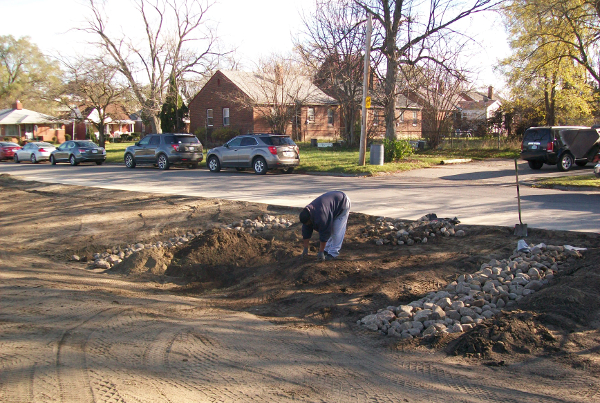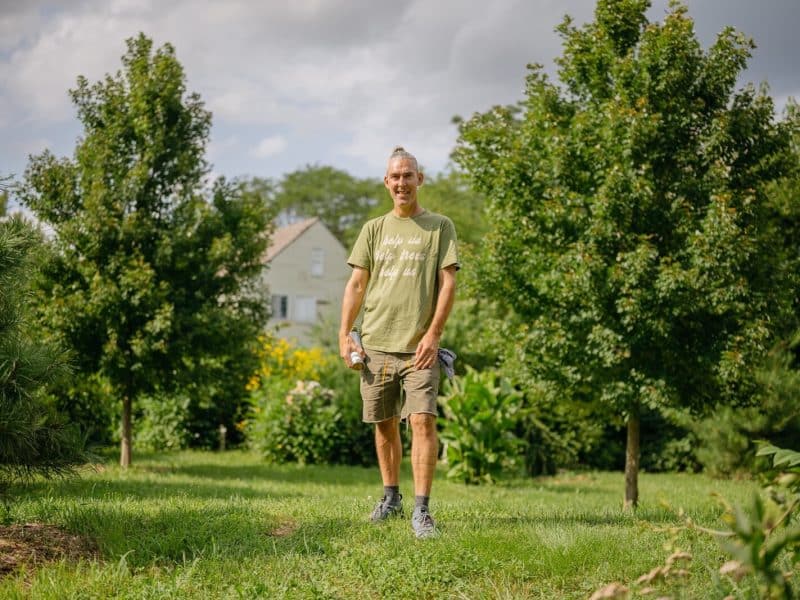How Cody Rouge is becoming Detroit’s leading neighborhood for green infrastructure
Flooding has long been an issue for Detroit's Cody Rouge neighborhood, but nonprofits, the city, and residents are taking action to mitigate the negative effects of stormwater on the community. Their latest project, a bioswale in Stein Park, is currently under construction.
Cody Rouge, a neighborhood abutting the Rouge River on Detroit’s west side, is well known for flooding. During the Great Flood of 2014, one area of the neighborhood was inundated with over five inches of rain, more than anywhere else in the city over the course of that record-breaking August deluge. In addition to flooding streets and basements, hard rains like those of 2014 can exceed the capacity of Detroit’s aging sewer system, resulting in the release of untreated, polluted water into the Rouge and Detroit rivers.
But Cody Rouge is taking action to mitigate the negative effects of stormwater and, in the process, is becoming the city’s model neighborhood for green infrastructure implementation. The neighborhood’s latest project, a bioswale, is under construction this week in Stein Park.
What exactly is a bioswale, you ask? It’s a special urban landform designed to collect rainwater and increase stormwater infiltration. Bioswales are often placed in areas where flooding is common because they help divert water that would contribute to overloading a sewer system during a significant storm event.
The first privately-funded project of its kind on public land in Detroit, the Stein Park bioswale was jointly developed by the Greening of Detroit and the Joy-Southfield Community Development Corporation. It’s made possible by an $83,000 Kresge Foundation grant, which will also be used to install solar-powered LED lights in the park and fix up sidewalks.
Dean Hay, Greening of Detroit’s director of green infrastructure, describes the blue/green project as a combination of landscaping and vegetation.
“Curb cuts will allow water to gravity feed through a three-foot filter strip that is constructed out of ornamental grasses that will filter all the sediment and the trash out of the water so that only pure, clean water will flow down through the trough and store in the pond,” he says.
The plant material in the trough will be a mix of prairie wildflowers. On its sides, the bioswale will be surrounded by trees and shrubs of both native and landscape varieties. According to Hay, the project has been designed to have very low implementation and maintenance costs.
Construction crews began digging trenches and making curb cuts on Tuesday. A “green team” of students from Cody DIT High School will help with planting, which starts Thursday and should wrap up by Saturday, Nov. 21.
Once completed, the bioswale will be able to divert up to 6,000 gallons of stormwater from the sewer system during a storm event, greatly reducing the amount of sediment and pollutants entering the Rouge River.
David Law, executive director of the Joy-Southfield CDC, says he would like to see more bioswales at the site in the future. While the CDC’s director is excited about the stormwater reduction aspect of the project, he also sees the bioswale as part of a broader endeavor to revitalize the neighborhood.
“This project is going to make Stein Field a much more inviting place for people to go and exercise and go for a walk. It’s going to create sense of place, a sense of pride,” he says.
His organization is also working to transform a section of Joy Road into a complete street. Law says the goal of this work isn’t gentrification or displacement, but restoring the neighborhood to being a “healthy, self-reliant community where people have access to resources to be healthy and productive.”
In addition to the bioswale, the Greening has planted more than 4,000 trees in the neighborhood with the assistance of the Detroit Water and Sewerage Department.
At Tuesday’s groundbreaking, the organization’s president, Rebecca Salminen Witt, emphasized that the bioswale wasn’t a “standalone project,” but part of a long-term effort to “secure the ecosystem” of the neighborhood.
“We’ve done parks here. We’ve helped people disconnect their downspouts, so they don’t go straight into the sewer or basement,” she says. “All of those things add up to a more ecosystem-friendly neighborhood and makes this neighborhood a model for other neighborhoods that want to be green all across the city.”
David Sands is a Detroit-based freelance writer. Follow him on Twitter @dsandsdetroit.
All photos by the author.









